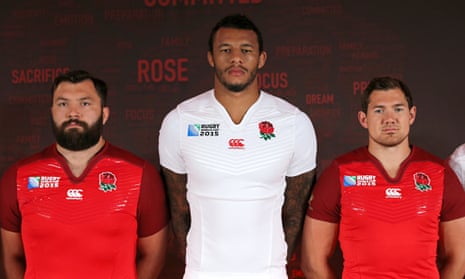The ultimate performance fabrication. So boast England’s kit manufacturer, Canterbury, which may explain why the men in white have developed a tendency to finish second.
The performance in question, though, is that of the latest of England’s jerseys, which were unveiled at Twickenham on Monday in the buildup to the World Cup, with a top price of £120. Fabrication is not a word often mentioned at media launches but the new home shirt, which is white and looks just like the previous one, apart from a World Cup logo, “features dynamic heat-management properties which are made to withstand the harshest on-field conditions whilst enabling players to perform at their best with zero distractions”.
Nike made a number of boasts a few World Cups ago after producing an England jersey that revealed even the most modest of contoured stomachs and had the distraction of numbers coming unstuck and littering the turf. Kit-speak was drawn up by estate agents.
Alex Corbisiero, the Lions prop, was given the responsibility of showing off the latest shirt, although he was clad in the alternate one of red – will England play mind games with Wales and insist on wearing the change strip in the World Cup group match at Twickenham against their foes from the other side of the Severn? – on behalf of the tight forwards, who are not so described because they take much longer to squeeze into what passes for a rugby jersey today than their sleeker colleagues.
There are compensations, such as a “ball-deadening” grip replacement to enhance physique. For those punters prepared to pay a three-figure sum to sport the exact jersey worn by the players, as opposed to a reproduction, read beer-glass deadening grip; well worth the extra outlay for those expecting to have a multi-pint order during a match.
The red rose on the jersey has changed, apparently. It is now in 3D, which the manufacturer does not expect to stand for defeats by Fiji, Australia and Wales. “Developed through rapid prototyping technology, it will stand out in a way that merits the significance of the rose for players and fans alike.” The importance of supporters, ie those who the manufacturers expect to buy the products, was stressed throughout the launch of a shirt that apparently is the result of more than 220 hours of testing.
Those at the launch were told that, in a bid to minimise moisture absorption, it was Canterbury’s “most lightweight kit ever”. Like fabrication, lightweight was not a word the World Cup hosts would have wanted to be associated with.
A shirt, it appears, is no longer just a shirt but something to hold up as a work of art and science. The RFU was soon forced to defend its pricing policy, trotting out the old football argument that no one was being forced to buy one. If no one did, of course, the likes of Canterbury would have to find something else to do, there would be no more kit launches at HQ and jargon would suffer a drop.
Like match tickets, however, the ninth and 10th England jerseys in a year will sell, never mind the strip-off.

Comments (…)
Sign in or create your Guardian account to join the discussion